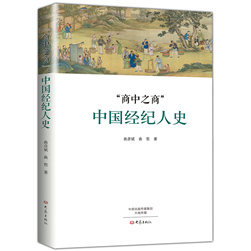Yashang: core of the traditional commercial system
Author : ZHOU SUYUAN Source : Chinese Social Sciences Today 2018-03-15

Merchants amid merchants: The History of Chinese Brokers
Author: Qu Yanbin
Publisher: Elephant Press
Yashang, a profession in ancient China, responsible for promoting business deals, had been at the core of traditional business system. It played an important role in the Chinese history of business and economic development. From ancient fairs to modern intensive, large-scale and specialized large markets for commodities, business activities depended on brokers. Moreover, the more developed the society, the more vigorous the market economy and thus the more it will emphasize the role of brokers. Therefore, it can be said that “where there are markets, there are brokers.”
Within market activities, brokers are intermediaries seeking profit from intervening services. The development of broker industries at all times and in all countries has shown that business activities of all trades and professions require intermediary services. As an indispensable link in the economic order, brokers form a great business industry. Qu’s book Merchants amid Merchants: History of Chinese Brokers researches the history of brokers in China.
In the past 40 years since China’s reform and opening up, all kinds of brokers in all walks of life have been quite active and become important symbols of prosperity in various industries. However, Chinese brokers are not a foreign construct but have a long history of more than 3,000 years. In the book, Qu summed up the historical development of the Chinese broker industry in his own words with a few lines: the Zhou and Qin dynasties had zhiren (the earliest brokers in China) while the Han had warehouses; the Jin Dynasty brokers, kuai, would frequent the stores in the market; in the Sui and Tang dynasties there were brokers involved in foreign trade; the Song, Jin and Yuan dynasties followed the traditions; the Ming and Qing dynasties witnessed a new normal. Especially in the Qing Dynasty, foreign trade prospered as the thirteen-hong set in Guangzhou; the reform and opening up give rise to brand new conditions.
Through analysis of the historical data, Qu suggests there are three basic rules for the development of China’s broker industry. First, the brokers differed from industry to industry. That is, they differ according to the target industries they serve. Second, the rise and fall of the broker industry always accompanied the fluctuation of the market. In the era when cattle and horses were used for production, transportation and military use, there emerged brokers represented by zangkuai, who were originally specific brokers for horse dealers and later became the general term for brokers.
Since the Tang and Song dynasties, with the gradual specialization of the division of labor brought about by the mature of professions and the prosperity of the commodity economy, the division of labor of brokers was also correspondingly specified. Almost all kinds of commercial brokers emerged as professional brokers. At the end of the Qing Dynasty and the beginning of the Republic of China, with the gradual development of foreign trade in Guangzhou, Shanghai, compradors were even more active and formed the “bureaucratic comprador bourgeoisie.” Third, due to many industrial differences, there were no common customs of the broker industry.
(Edited and translated by SUI JINGJING)
Ye Shengtao made Chinese fairy tales from a wilderness
Ye Shengtao (1894–1988) created the first collection of fairy tales in the history of Chinese children’s literature...
-
How northern ethnicities integrated into Chinese nation
2023-09-18
-
Mogao caves
2023-09-12
-
Mogao Grottoes as ‘a place of pilgrimage’
2023-09-12
-
Time-honored architectural traditions in China
2023-08-29
-
Disentangling the civilizational evolution of China
2023-08-28
-
AI ethics in science fiction
2023-08-23














 2011-2013 by www.cssn.cn. All Rights Reserved
2011-2013 by www.cssn.cn. All Rights Reserved